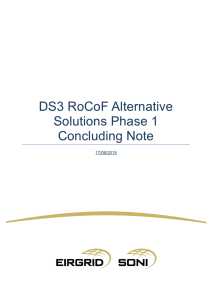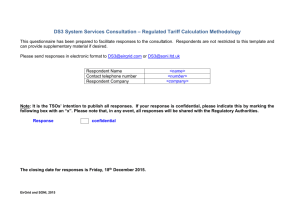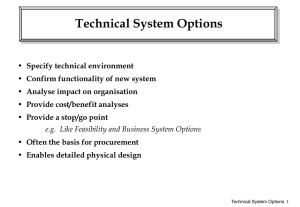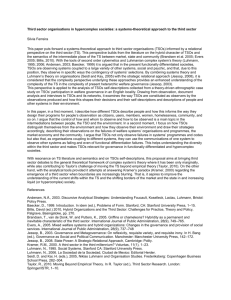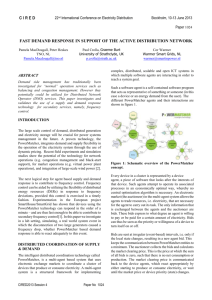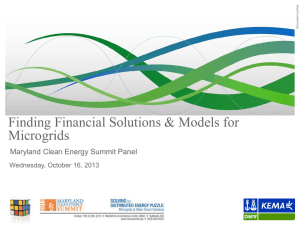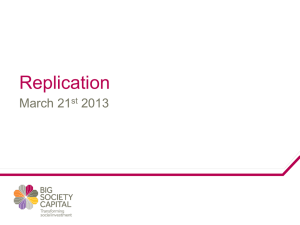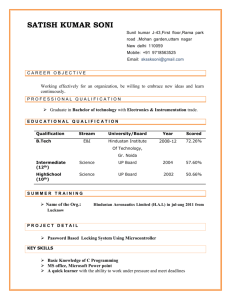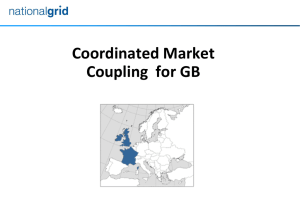DS3 RoCoF Alternative Solutions Project Phase 1
advertisement
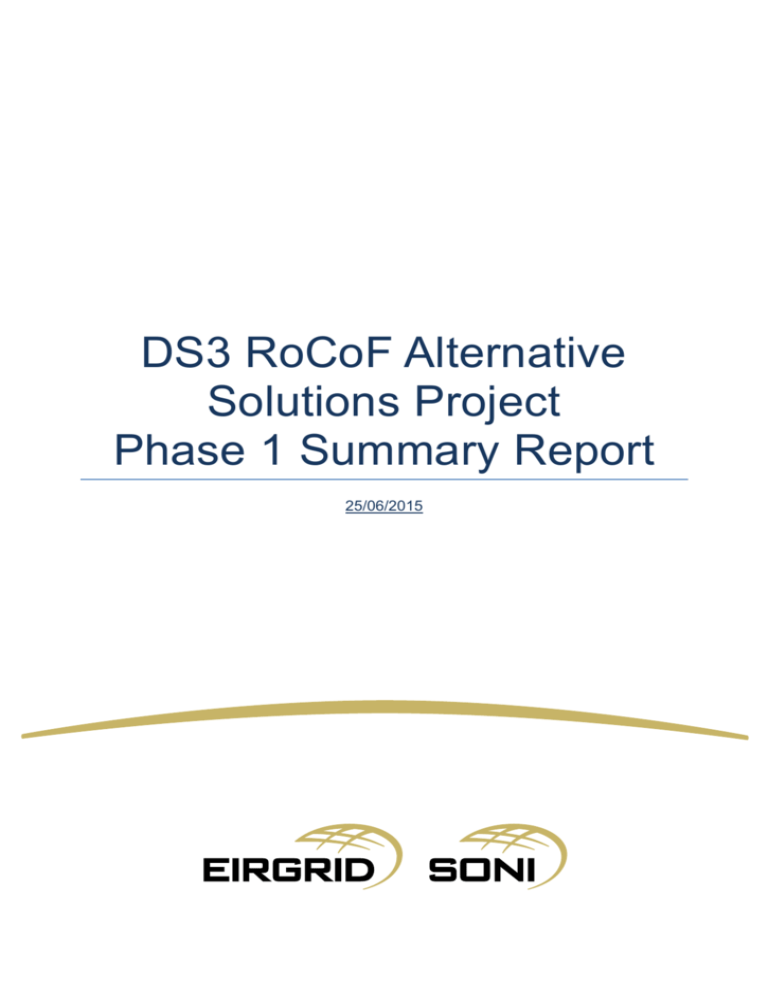
DS3 RoCoF Alternative Solutions Project Phase 1 Summary Report 25/06/2015 Introduction In April and May 2014, the Commission for Energy Regulation (CER) and Utility Regulator (UR) respectively decided in principle to introduce a Rate-of-Change-of-Frequency (RoCoF) Grid Code standard of 1 Hz/s (calculated over 500 ms) in Ireland and Northern Ireland. The Grid Code modifications will only come into effect following confirmation from the TSOs that, from a system security perspective, they can be implemented. To determine this, the CER and UR directed that an industry implementation project comprising three strands be established. These three strands are as follows: 1. 2. 3. Generator Studies Project TSO-DSO Implementation Project Alternative Solutions Project The Generator Studies Project is aimed at assessing if generators can tolerate the higher 1 Hz/s (calculated over 500 ms) RoCoF values. The TSO-DSO Implementation Project seeks to make changes to Loss of Mains protection in the distribution system such that high RoCoFs will not disconnect large quantities of embedded generation. The CER and UR are targeting a phased implementation of this new RoCoF standard over a period of 18 to 36 months. However, the CER and UR are of the view that there is a risk that implementation could take longer than this and that the new RoCoF standard may potentially not be implementable in a timely enough manner to allow achievement of the 2020 renewable energy targets. In that context, the CER and UR have also directed the TSOs to investigate alternative or complementary solutions to the inertia problem that the RoCoF Grid Code modification is intended to resolve. The various possible alternative solutions are based on keeping sufficient inertia on the system (or the provision of sufficiently fast response) so that RoCoF values do not exceed 0.5 Hz/s (or some higher value that is acceptable). The TSOs wish to emphasise that the priority is to deliver on the Generator Studies and TSO-DSO Implementation projects. EirGrid and SONI remain of the belief that generator compliance with the proposed new RoCoF standard is the most efficient and timely solution. Nonetheless, the TSOs are also of the view that sources of additional system inertia are of value to the system and would complement the implementation of the generator studies and TSO-DSO projects. In this light, the RoCoF Alternatives Solutions Project aims to provide insight into how additional system inertia could be deployed. The RoCoF Alternative Solutions Project is essentially a technology assessment from a RoCoF mitigation perspective only. The scope of the project does not include assessment or establishment of the commercial arrangements for the delivery of any potential alternative solutions, nor does it constitute a first step in a procurement process. DS3 System Services, DS3 RoCoF Alternatives Project– TSOs’ Phase 1 Summary Report Page 2 Energy market and Capacity Remuneration Mechanism (CRM) will provide a possible commercial route to market for new technologies and potential system service providers. Outline of RoCoF Alternative Solutions Project In November 2014, EirGrid and SONI engaged with industry representatives on the scope of the RoCoF Alternative Solutions Project. The TSOs finalised the scope and project plan following feedback from industry representatives. The project plan was divided into two phases: Phase 1: The initial phase of the project involves a review of potential alternative or complementary technology solutions to changing the RoCoF standard from 0.5 Hz/s up to 1 Hz/s. A range of theoretical options are assessed at a high level via a weighted scoring matrix approach. The scoring criteria will include, at a high level, technical, technology maturity and lead-time assessments. The high-level assessment aims to provide the basis for the more detailed analysis to be conducted in Phase 2. • Phase 2: A more detailed review of selected options from Phase 1 is to be carried out. The focus of this analysis will be on the technical and economic aspects of each of the shortlisted options. The analysis will involve technical and techno-economic simulations. In April 2015, EirGrid and SONI commissioned DNV GL to conduct a technology assessment of thirteen technology types under several key metrics relevant to the RoCoF issue. DNV GL developed a weighted scoring matrix to perform the high-level assessment of each the technology types. EirGrid and SONI are pleased to announce the publication of the “RoCoF Alternatives Technology Assessment” report which details the analysis conducted by DNV GL. Phase 1 Report Outline The “RoCoF Alternatives Technology Assessment” report compiled by DNV GL aims to provide a high-level assessment of each technology as part of the Phase 1 scope outlined by the TSOs following industry feedback. The paper begins by introducing the concepts of synchronous and non-synchronous (synthetic) inertia. The differentiation of both types of inertia provision is important as all technologies included in the report fall into one of the two categories. The paper then discusses RoCoF detection methodologies and introduces the concept of response time for a non-synchronous device. EirGrid and SONI view detection methodology and response time as being key parameters associated with the provision of inertia from non-synchronous devices in a manner that would enable RoCoF mitigation. This discussion considers the provision of inertia for the purposes of RoCoF containment and does not consider provision of other frequency containment services. DS3 RoCoF Alternatives Project– TSOs’ Phase 1 Summary Report Page 3 The report then introduces the technology assessment that was performed by DNV GL. A high-level assessment of the characteristics of each of the 13 technologies is presented in a one-page ‘faceplate’. The faceplate assessments consider characteristics of each technology that are relevant to the RoCoF challenge. DNV GL used these assessments to contribute to the high-level technology assessment scoring matrix. A short narrative of each of the scoring assessments is also presented in the report. It should be noted that the technology assessments conducted in the report are high-level. Further detailed analysis of commercial, device technology characteristics and system impacts will be required, at the appropriate time, to fully assess the suitability of specific technologies in relation to avoiding high RoCoF events. Phase 1 Report Findings EirGrid and SONI welcome the analysis performed by DNV GL and view the report and its findings as being important in facilitating the conversation with industry on the possible solutions for avoiding high RoCoF occurrences. The TSOs note that both synchronous and non-synchronous devices may have the potential to provide responses that would prevent high RoCoF events. In the case of synthetic inertia there were some areas that need to be investigated in more detail. In particular, the TSOs view RoCoF detection methodology and response time as being an area that needs to be explored further. The TSOs would therefore welcome views from non-synchronous device and synthetic inertia providers on these issues. The weighted scoring matrix offers some interesting insights, although it must be noted that this was performed only at a high-level and is not a definitive assessment of the ability of specific technologies to provide high RoCoF mitigation services, nor of the costs of procuring such services. The weighted scoring matrix resulted in synchronous devices scoring higher, on average, than non-synchronous devices. This trend reflects the fact that synchronous inertia is currently the most proven technology for preventing high RoCoF occurrences. The trend also reflects that synchronous devices do not face the challenges of RoCoF event detection as is the case for non-synchronous devices. The TSOs note that, at this stage, the scoring matrix does not result in a clear favoured approach to resolving the RoCoF challenge. The TSOs also note that rather than having one specific technology solution, a combination of technologies will likely need to be deployed. EirGrid and SONI would welcome the views of industry on the high-level technology assessments in terms of RoCoF mitigation. RoCoF Alternatives Project Next Steps The DNV GL report has offered significant insight into the capabilities of a wide range of technologies in terms of high RoCoF avoidance. The report also highlights some of the challenges that exist in deploying specific device types. EirGrid and SONI view the report as DS3 RoCoF Alternatives Project– TSOs’ Phase 1 Summary Report Page 4 completion of Phase 1 of the RoCoF Alternatives Project. The TSOs anticipate that the report will facilitate the engagement with industry on the RoCoF alternative or complementary solutions and would welcome further information from industry on some of the key areas of the report before embarking on Phase 2 of the RoCoF Alternative Solutions Project. EirGrid and SONI aim to undertake more detailed technical and techno-economic assessments of a range of technologies as part of the Phase 2 assessments. At this stage, given the range of results obtained from the weighted scoring matrix, the TSOs do not view the benefit in discounting any of the specific technologies analysed in the DNV GL report. The exception is the option of constructing an AC interconnection to Great Britain as the timelines for achieving this appear to be beyond the timeframe of interest for the RoCoF project. It is therefore proposed that, rather than assessing individual technology devices in detail, the Phase 2 analysis be conducted on the basis of generic synchronous and non-synchronous device responses. This approach would enable the TSOs to conduct analysis on the full range of devices based on their classification as synchronous or nonsynchronous and to provide useful information about the quantities of each class of device required. The projected timeframes for completion of the Phase 2 analysis is quarter four 2015, with a final report to be issued for industry review in the first quarter of 2016. It is envisaged that this project will include technical and techno-economic assessments of the potential solutions. It should be noted that all analyses conducted in Phase 2 of the project will be from the perspective of resolving the RoCoF issue only and is not an assessment of each technology’s ability to provide DS3 System Services. An assessment of the provision of system services will be conducted as part of the DS3 System Services project. Summary EirGrid and SONI commissioned DNV GL to conduct a technology assessment of thirteen technology types under several key metrics relevant to the RoCoF issue. DNV GL has compiled the report titled “RoCoF Alternatives Technology Assessment”. The report aims to facilitate industry engagement on the RoCoF issue and has raised some of the key challenges relating to RoCoF. EirGrid and SONI would welcome the feedback from industry on the report and would welcome input prior to proceeding with the RoCoF Alternative Solutions Project Phase 2 analysis. DS3 RoCoF Alternatives Project– TSOs’ Phase 1 Summary Report Page 5
